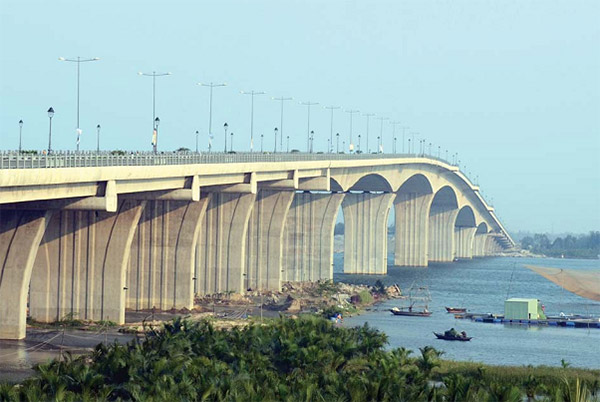 Vietnamese
Vietnamese
Quang Nam’s table set for investor feast
Quang Nam’s table set for investor feast
The great achievements the central province of Quang Nam has posted in recent years have solidified its position as a magnet for domestic and foreign investment this year – during the province’s 20th anniversary of re-establishment.
 |
| The Cua Dai bridge, which was open to traffic early last year, has elevated Quang Nam’s development |
Abounding potential
Quang Nam has emerged as a fertile land for domestic and foreign investors alike. The presence and long-term commitment of leading players such as Truong Hai Auto Corporation (THACO), Suntory-PepsiCo, Vietnam Brewery Ltd., and famous tourism brands such as The Nam Hai are vivid examples of this.
The province’s advantages come primarily from its strategic position in the middle of Vietnam, belonging to the pivotal central economic region.
The province borders Danang – a trade, services, and training centre of the central region – in the north, adjoins Laos in the west, and lies within the East-West Economic Corridor. Its location makes it conveniently positioned to facilitate transport to Laos, Cambodia, Thailand, and Myanmar by road, and seaborne transport to other ASEAN members.
Within a 3,200 kilometre radius of Quang Nam lie East Asia’s most dynamic economic regions, including Singapore, China, South Korea, and Japan. Its strategic positioning and synchronised infrastructure systems have made Quang Nam an alluring investment destination for a variety of industry sectors.
As for air transport, Quang Nam lies in the middle of the central region’s two major airports – Chu Lai in the province’s Nui Thanh district and Danang, which is 70km from Tam Ky town.
In terms of seaborne transport, Quang Nam is in the hub of two international seaport systems – Danang and Ky Ha – and near the north-south international maritime route, strategically located to promote goods transport to destinations at home and abroad.
The province is now home to eight industrial zones (IZs) and 50 industrial clusters (ICs). Most of them are located near main roads, cover large spans of land, and feature relatively comprehensive infrastructure facilities (water, power, and telecommunications systems, for example).
Local authorities’ reports show that the province currently accommodates more than 5,300 world-class hotel rooms, many of which were developed by renowned brands, focusing on the coastal area, turning Quang Nam into one of the most alluring investment destinations in the central region.
Opening the door to investors
Big international organisations such as UNDP, UNESCO, and World Bank have landed a string of co-operative deals with the province on socio-economic infrastructure construction and promoting cultural exchanges, among others.
In the long-run, Quang Nam focuses on attracting investment into areas in which the province has strong advantages, such as supporting industries, processing, high-tech agriculture, urban and tourism services, human resources training, IZ and IC infrastructure investment, and construction.
According to the Public Administration and Investment Promotion Centre of Quang Nam, businesses operating investment projects in areas with difficult conditions for development, in Chu Lai Open Economic Zone, and projects in priority investment fields such as high-tech agriculture, science and technology research, and vocational training are entitled to investment incentives. These include 10 per cent corporate income tax (CIT) in the first 15 years after incurring taxable income, CIT exemption for four years, and 50 per cent reductions for nine consecutive years.
Quang Nam is also appealing to investors because the rental rate applied to land having infrastructure at IZs equals one-third of that in other localities.
Chairman of the Quang Nam People’s Committee Dinh Van Thu said that as Vietnam is integrating deeper into the world economy, Quang Nam is making constant efforts to improve its competitiveness. The province has taken a raft of measures to create a better investment climate and scale up support for businesses, turning the province into an attractive destination for investors.

